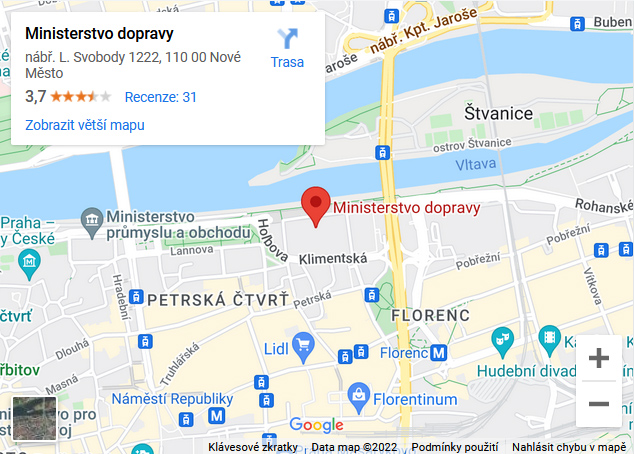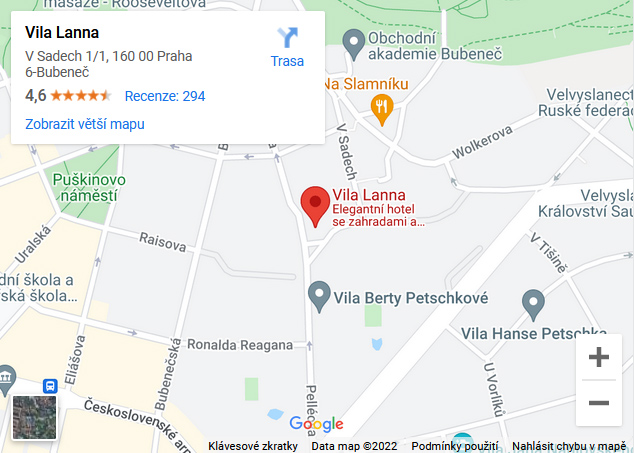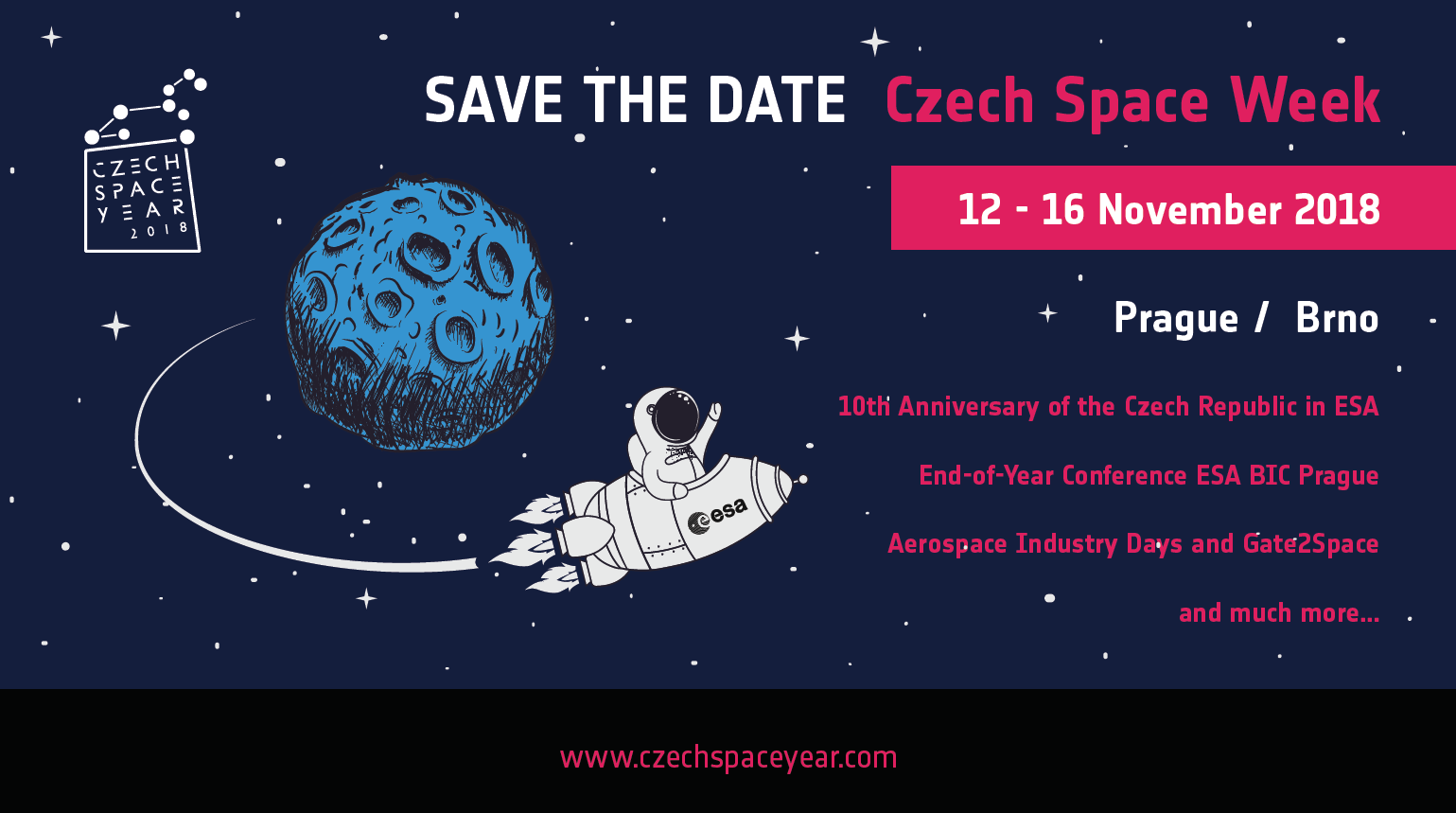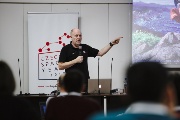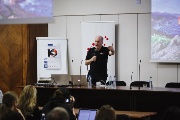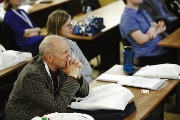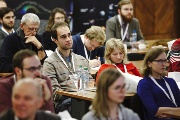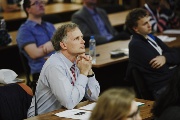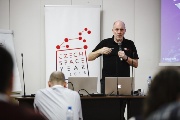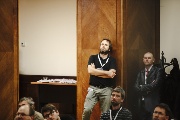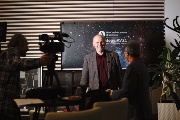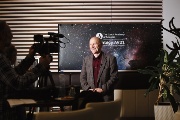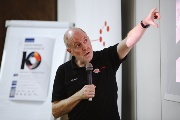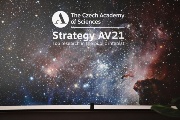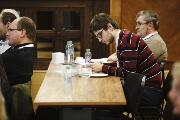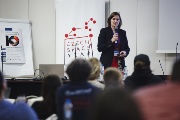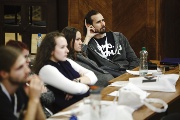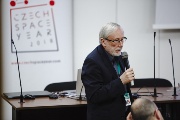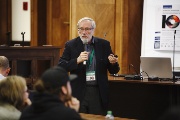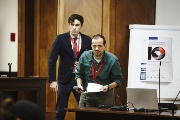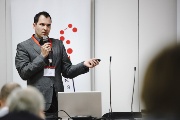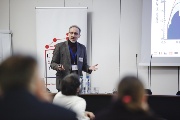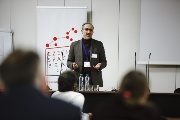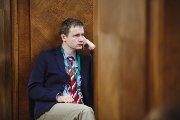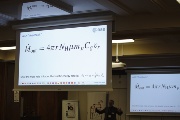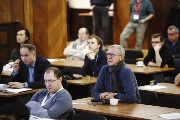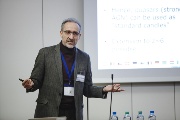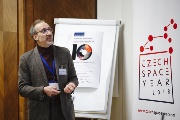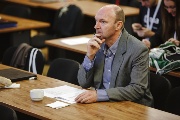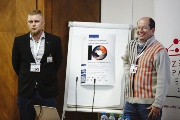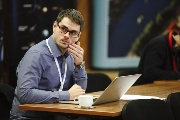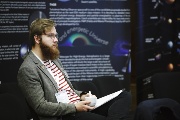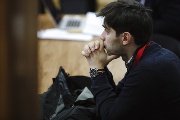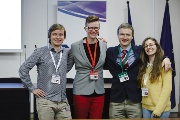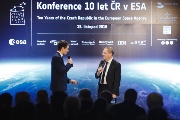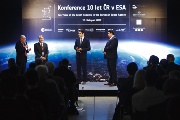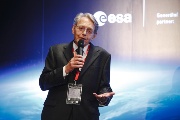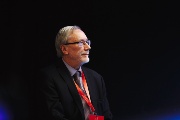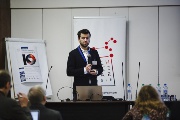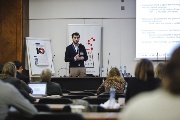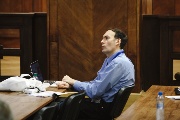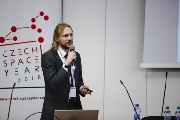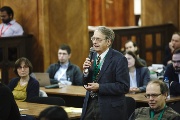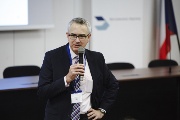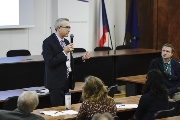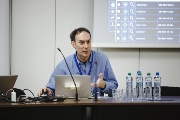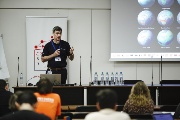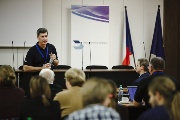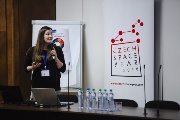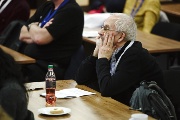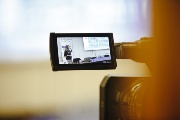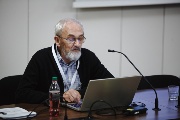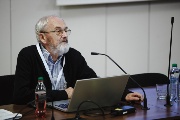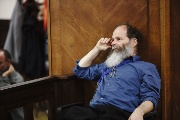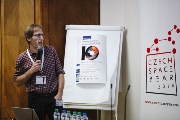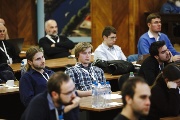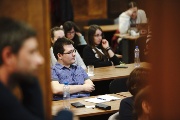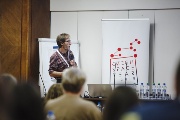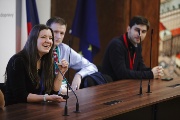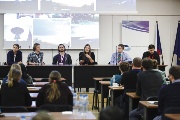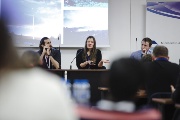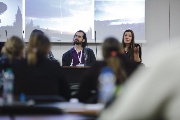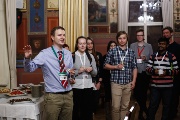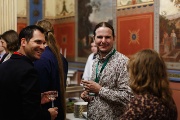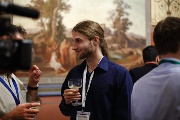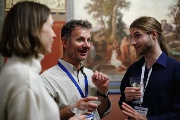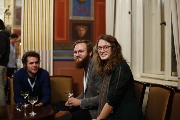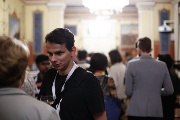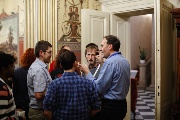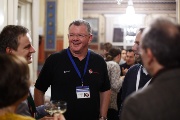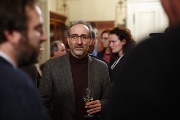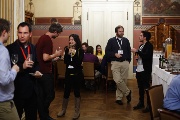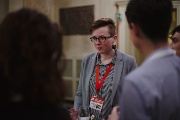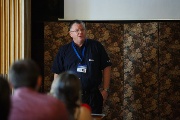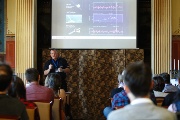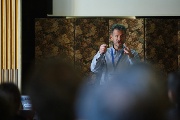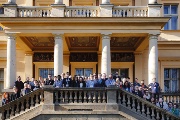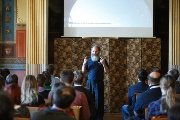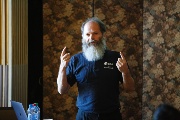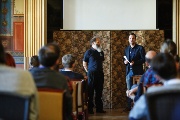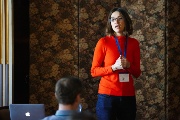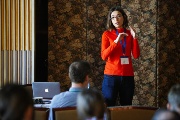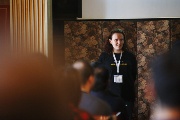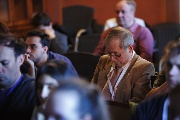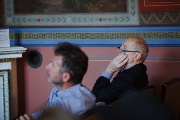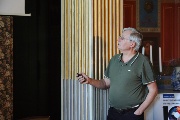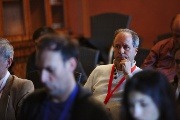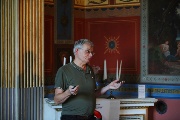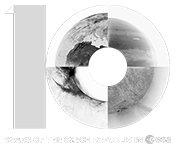Scientific Workshop for Students and Young Researchers on the Anniversary of
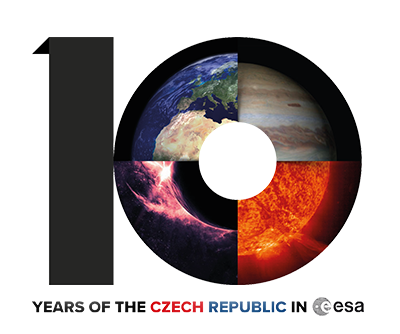
Part of the Czech Space Week 2018

News
News:
We have just added our Photogallery. Click here to relive your favorite moments from the workshop!
Our workshop has ended. We believe that it was a great success and that you enjoyed the meeting as we did! We would like to thank all speakers and participants for very inspiring talks and discussions.
See you in 2028 for 20 year's anniversary at the latest!
Video records of the workshop on Facebook:
Topics
- Space research, Earth observations and Technology innovations with ESA
- Presentation of the Czech participation in scientific and technical projects of ESA
- ESA opportunities for young researchers and students
- Prospects and discussion of further collaboration with ESA
Invited speakers
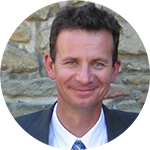
Bruno Altieri - ESA/ESAC
My main research interest is on deep cosmological surveys to address the following astrophysical issues:
• Properties of the most distant galaxy clusters and proto-clusters.
• What is the evolutionary sequence which lead star formation to migrate from high-z overdensities to low density regions in the local universe?
• Resolve the Cosmic Infrared Background and determine the nature of its constituents.
• Determine the cosmic evolution of dusty star formation and of the infrared luminosity function.
• Elucidate the relation of far-infrared emission and environment, and determine clustering properties.
• Determine the contribution of AGN. Determine the infrared emission and energetics of known galaxy populations.
• The search of Solar System Objects in deep optical surveys.
Didier Barret - CNRS
Didier Barret is a high-energy astrophysicist working at the Institute of Research in Astrophysics and Planetology of Toulouse. His scientific research is centered on the analysis and the interpretation of X-ray data collected by space observatories from X-ray binaries, containing black holes and neutron stars. He is currently the Principal Investigator of the X-ray Integral Field Unit (X-IFU) to fly on board the Athena X-ray Observatory, the second Large mission of the Cosmic Vision program of the European Space Agency.

Tina Büchner da Costa - ArianeGroup
Tina Büchner da Costa is a passionate senior aerospace engineer who worked as system engineer, project manager and, in her last assignment, as department head for future launcher technologies in ArianeGroup. She was involved in propulsion testing and procurement activities for the Automated Transfer Vehicle, led the development of the attitude control system of the Ariane 5ME launcher (before the project became Ariane 6), and was responsible for the preparation of the test facility for the entire upper stage of the Ariane 6 launcher together with the German Aerospace Center. She has a degree in aerospace engineering and a master in business psychology, worked in ESA-ESTEC on concurrent engineering design and participated in the Summer Session Program of the International Space University. She also went through the German female astronaut selection in 2016 and made it among the last 10 candidates.

Marco Feroci - INAF/IAPS, Rome
Marco Feroci is a Research Director at the Institute of Space Astrophysics and Planetology of INAF (Italian National Institute for Astrophysics) in Rome. He works in the field of X-ray astronomy, developing new instrumentation for space missions. He is currently coordinating the European Consortium supporting the development of the Sino-European eXTP mission to study the behaviour of matter and radiation under extreme conditions of density, gravity and magnetism in the vicinity of black holes and neutron stars. He is also contributing to the HERMES project, a constellation of cubesats for the study and localization of gamma-ray bursts.
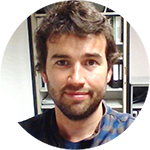
Ivo Ferreira - ESA/ESTEC
Ivo Ferreira (PhD) is a systems engineer and technology development lead at ESA ESTEC in Noordwijk (Netherlands). Working for the Future Missions Department of the Science Directorate.
He is mostly supporting the ATHENA mission, and juggles his time between:
• the coordination of requirements and industrial activities around the design of the ATHENA spacecraft and,
• the proposal, management and development of the diverse technologies for this mission, such as innovative silicon pore optics or magnetic diverters.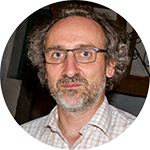
Matteo Guainazzi - ESA/ESTEC
My main research interests focus on high-energy observations of Active Galactic Nuclei (AGN). I have recently used X-ray observations of nearby AGNt galaxies to study: a) the ionization mechanism of the Narrow Line Regions; b) the location and dynamics of optically-thick gas and dust in the innermost ~pc around supermassive black holes. Exciting times are come for AGN science, with the unprecedented spectroscopic capabilities of the micro calorimeters on board XRISM and Athena to become operational during the next decade. I am involved in the preparation of future missions as Project Scientist of the ESA contribution to XRISM, and Study Scientist for Athena and THESEUS.
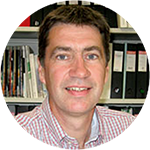
Roger Haagmans - ESA/ESTEC
Senior advisor Earth Observation and GOCE, Swarm and G-CLASS mission scientist.
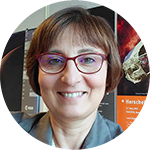
Ana Heras - ESA/ESTEC
Ana Heras is Project Scientist of the PLATO mission, that will search for terrestrial exoplanets orbiting in the habitable zone of stars like our Sun. Ana obtained her PhD from the University of Barcelona, and joined ESA to work on the science operations of the Infrared Space Observatory. Later she became Deputy Project Scientist of the Herschel Space Observatory, and was Project Scientist of CHEOPS, that will also study exoplanets. Her research interests are the study of dust formation in evolved stars, debris disks detection around sun-like stars, and more recently, the study of exoplanets and their host stars through multi-band observations of planetary transits.

Michel Lazerges - ESA Prodex
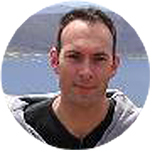
Guido de Marchi - ESA/ESTEC
My main scientific interests include star formation, the study of resolved stellar populations, the structure of star clusters and their dynamical evolution, and the properties of the interstellar medium. I make extensive use of the HST and the VLT in my research and work with data from the UV to the near IR. I lead a research programme with JWST on star formation in the local group.

Mark McCaughrean - ESA/Directorate of Science
Prof. Mark McCaughrean is the Senior Advisor for Science & Exploration at the European Space Agency. He is also responsible for communicating results from ESA’s astronomy, heliophysics, planetary, exploration, and fundamental physics missions to the scientific community and wider general public. Following a PhD from the University of Edinburgh, he worked at the NASA Goddard Space Flight Centre, followed by astronomical institutes in Tucson, Heidelberg, Bonn, and Potsdam, and taught as a professor of astrophysics at the University of Exeter before joining ESA in 2009. His personal scientific research involves observational studies of the formation of stars and their planetary systems, and he is also an Interdisciplinary Scientist for the NASA/ESA/CSA James Webb Space Telescope.
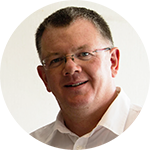
Paul McNamara - ESA/ESTEC
My scientific interests lie in the observation of the universe through gravitational waves, in particular, the low frequency gravitational wave spectrum which will be observed by LISA. Gravitational wave astrophysics is in its infancy with the recent observations of merging stellar-origin black holes (SOBH) and neutron stars with the ground based, high frequency, gravitational wave detectors. However, LISA will offer complementary science by observing the gravitational wave signatures from, for example, merging supermassive black holes (SMBH), or the capture of SOBH by massive black holes at the centre of most galaxies.
I have been actively involved in the LISA mission since the mid-1990’s, when my research was focused on the design and development of the laser interferometric measurement system at the heart of the mission. In recent years, I have been more focused on the physics and data analysis of the optical metrology and inertial sensing systems required by spaceborne GW observatories, in particular those related to the LISA Pathfinder mission, on which I served as the Project Scientist. I am now the Study Scientist of LISA, and am focused on the design of the instrument, as well as the preparation for the analysis of the LISA data.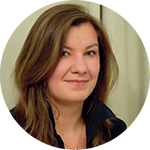
Tereza Šmejkalová - Serco Italia
I work as a remote sensing specialist for the RUS Copernicus service at Serco Italia. RUS Copernicus is a project funded by the European Commission and managed by the ESA. Its main task is to promote the uptake of Copernicus Sentinel data and enable the development of new applications and use scenarios. My main task is to design and deliver training on the use of remote sensing data from the Sentinel missions as well as direct support to the users. Prior to joining the RUS Copernicus project, I have spent a year as a Young Graduate Trainee at ESA ESRIN looking at iceberg monitoring using Sentienl-1 SAR data and I continued this work at the Center for Cold Ocean Resources Engineering in St. John’s, Newfoundland.
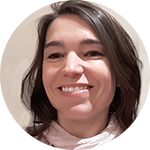
Claire Vallat - ESA/ESAC
Claire Vallat is an operations Scientist, working at the European Space Astronomy Centre (ESAC, Madrid, Spain).
Following a PhD in Space Plasma Physics from the University of Toulouse, she has been working as a liaison scientist for the Rosetta Science Operations Centre. She is currently working on the JUICE project, the first L-class mission of the ESA Cosmic Vision 2015-2025 program. Besides participating to the Science Ground Segment system development, she supports the science team in the development of the JUICE science activity planning.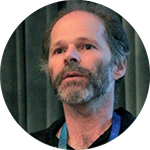
Joe Zender - ESA/ESTEC
Among my main research interests are Meteor Research with emphasis on spectral meteor data analysis, Solar Corona with emphasis on the study of long-term solar corona analaysis, and Mercury Science, especially the interaction of the solar wind with Mercury.
As member of ESA's Meteor Research Group (MRG), but also member of several amateur or professional observation teams, I have taken part and contributed to several meteor observation campaigns in the past (Leonid Campaigns in 1999, 2001, 2002; Geminid Campaign in Norway, 2005; Draconid Airplan Campaign in 2010).
Besides operating the cameras, I have a dedicated interest in analyzing the data from the spectral camera. Since some time, we have been working on a fully automated calibration pipeline that is now reasonably advanced, but still awaiting carefull and thourough validation.
Besides the main known problems of Solar Physics, we are interested to better understand which parts of the solar atmosphere are contributing and in which way to the long-term evolution of the solar irradiance, i.e. the solar cycle.
To help us answer this question, we segment the solar disk into Active Regions, Coronal Holes, Solar Limb, and the rest (Quiet Sun). These segmentation we apply to several wavelength in the EUV and magnetometer data from Proba 2-SWAP and LYRA, and SDO/AIA and HMI on data from 2010 onwards.
Programme
Programme
Monday 12 November
Afternoon I: Welcoming talks
Introduction of academic institutes interested in space projects
Afternoon II: Overview of ESA science and exploration & Space missions to the Sun
- 13:00 – 13:20 Jiří Dušek, Václav Kobera, Jiří Svoboda Welcome
- 13:20 – 13:30 Petr Heinzel Strategy AV 21 - Space for Mankind
Presentation [PPTX 7.4 MB]The Czech Academy of Sciences carries a set of top-level research projects which combine a basic research with certain added value for the society. One of them is VP16 called 'Space for Mankind', dedicated to space research in its broader context. We will briefly introduce this programme and review its current Activities which involve several institutes of the Academy.
- 13:30 – 13:40 Vladimír Karas Current and future synergies: astronomers vs. space researchers
Presentation [PDF 6.1 MB] - 13:40 – 13:50 Zdeněk Němeček Charles University
Presentation [PPTX 7.1 MB] - 13:50 – 14:00 Petr Páta Czech Technical University
Presentation [PDF 2.3 MB] - 14:00 – 14:10 Marek Skarka Masaryk University
Presentation [PDF 33.6 MB] - 14:10 – 14:20 Zdeněk Stuchlík Silesian University
Presentation [PDF 0.2 MB] - 14:20 – 14:30 Jan Souček Institute of Atmospheric Physics
Presentation [PDF 1.8 MB] - 14:30 – 14:50 Jan Kolář Beginning and development of cooperation with ESA
Presentation [PDF 26.1 MB]The first official contact with ESA came in 1996 when the MEYS on behalf of the government entered into the Framework agreement on cooperation with ESA under which umbrella the first space projects were accomplished. After signing the PRODEX access agreement in 2000, the Czech Republic became the member of the Plan for European Cooperating States in 2003. This step brought substantial increase number and professional level of projects in which Czech institutions learned the ESA rules and working environment. The necessity to create dedicated body taking care of all related agenda led to founding the Czech Space Office (CSO) in 2003. Supporting the Ministry of Education's decision-making role the CSO contributed to the national space research consolidation. Fourteen Czech organizations got their experience in 28 PECS projects under ESA control. The infrastructure created by CSO helped the Czech Republic to join ESA successfully in 2008. CSO managed the agenda of relationships with ESA and the Czech participation in the European space programs until 2011 when by a governmental decision the overall governance of the space activities was transferred to the Ministry of Transport.
- 14:50 – 15:30 Coffee break
- 15:30 – 16:30 Mark McCaughrean Once explorers, always explorers
The European Space Agency's science and exploration missions have been much in the news over the last few years, with the first results from its Gaia Milky Way surveyor and its LISA Pathfinder gravitational wave detection technology testbed, the arrival of its ExoMars Trace Gas Orbiter and Schiaparelli lander at the Red Planet, and the decade-long saga of the Rosetta comet-chasing spacecraft. I'll give you an insight into each of these missions, their challenges, and their successes (as well as the almost-successes), and tell you what's coming next in ESA science and exploration, including new missions to study the Sun, Mercury, Moon, Mars, and the wider Universe.
- 16:30 – 16:50 Tina Büchner da Costa Science and exploration are the WHY and WHAT - let’s talk about the HOW: an engineering perspective
Presentation [PPTX 2.7 MB]To get the science instruments into orbit and have them deliver the results that scientists are after, a big team of engineers is involved in the preparation and execution of space missions. Be it for the launcher that delivers the payload in space, the satellite, which hosts the instruments or the ground infrastructure that communicates with the satellite – many different engineering disciplines are needed for each and every science mission. This talk provides a short overview of the contributing engineering areas in the space field.
- 16:50 – 17:10 Petr Heinzel Czech participation in the Solar Orbiter mission of ESA
Presentation [PPTX 38.2 MB]The Czech Academy of Sciences carries a set of top-level research projects which combine a basic research with certain added value for the society. One of them is VP16 called 'Space for Mankind', dedicated to space research in its broader context. We will briefly introduce this programme and review its current Activities which involve several institutes of the Academy.
- 17:10 – 17:30 Jan Souček Radio and Plasma Wave Instrument for Solar Orbiter
Presentation [PDF 4.3 MB]The scientific payload of Solar Orbiter includes the Radio & Plasma Waves (RPW) instrument dedicated to measurements of solar radio emissions and in-situ plasma waves in the solar wind, important pieces in the puzzle of solar wind physics and its connection to the corona. The instrument was designed and built by an international consortium lead by Paris Observatory with important hardware contributions from the Institute of Atmospheric Physics and Astronomical Institutes of the Czech Academy of Sciences. The RPW instrument will provide novel high resolution measurements, advancing our understanding of the origin and propagation of solar and interplanetary radio bursts, interplanetary dust, physics of interplanetary shocks as well as other physical problems, such as solar wind turbulence. We will present the design and capabilities of RPW, describing the various measurements of electromagnetic field in a wide frequency range from a fraction of Hertz to 16 MHz, and the on-board data processing preformed by the instrument.
- 17:30 – 17:50 Stanislav Gunár The Proba-3 mission of ESA and the Czech contribution to its ASPIICS coronagraph
Presentation [PPTX 387 MB]We will present the Proba-3 mission of ESA and the contribution of the Czech Republic to the space coronagraph ASPIICS onboard. ASPIICS will make use of the unique formation flight technology to deliver unprecedented eclipse observations of the solar corona. Thanks to the long baseline separation (150 m) of the occulter (placed on the leading S/C) and the coronagraph itself (placed on the following S/C) ASPIICS will reach very low levels of stray light. This will allow us to observe the solar corona from its outer reaches to very close to the solar surface. This inner corona can be currently observed only during natural total solar eclipses, because all other ground-based or space-borne coronagraphs suffer from much higher levels of stray light than what will be achieved with ASPIICS. However, in contrast with the total solar eclipses - which occur only sporadically, last for a few minutes, and the observations during them are affected by the weather and geopolitical circumstances - ASPIICS will deliver regular long-lasting (several hours) observations of the corona. The Czech Republic contributes to the ASPIICS hardware development of the coronagraph entrance aperture door mechanism and the optical objectives. - 17:50 – 18:10 Iva Ambrožová DOSIS and DOSIS 3D on-board the ISS
Presentation [PDF 16.8 MB]The radiation environment in space differs in nature from that on Earth, resulting in radiation levels far exceeding the ones present on Earth. Accurate knowledge of the physical characteristics of the space radiation field in dependence on the solar activity, the orbital parameters and the different shielding configurations of the International Space Station (ISS) is therefore important.
The aim of the DOSIS (2009 – 2011) and DOSIS 3D (2012 – ongoing) experiment is the characterization of the radiation environment within the European Columbus Laboratory of the ISS. The measurements are performed with passive radiation detectors mounted at eleven locations within Columbus for the determination of the spatial distribution of the radiation field parameters and with two active radiation detectors mounted at a fixed position for the determination of the temporal variation of the radiation field parameters. The principal investigator of the project is Dr. Thomas Berger from German Aerospace Center, Cologne, Germany, more than 20 science team members (from various countries from Europe, USA, and Japan) are participating in this project. Nuclear Physics Institute of the CAS as one of the team members is responsible for providing and analysis of passive detectors (combination of thermoluminescent and plastic nuclear track detectors).
Tuesday 13 November
Morning: Astrophysics space missions with ESA - X-ray astronomy
- 9:00 – 10:00 Matteo Guainazzi Chasing the invisible: the high-energy sky as seen by ESA observatories
Presentation [PDF 47.4 MB]Starting from the EXOSAT mission in the 1980s, the European Space Agency (ESA) has been at the forefront of the scientific investigation and technogical development in the field of high-energy astrophysics (X-rays and gamma-rays). Entire classes of fascinating celestial sources such as black holes, neutron stars, galaxy clusters and groups (the largest gravitationally-bound structures in the Universe), and the remains of powerful supernova explosions can be studied solely or optimally in this band of the electromagnetic spectrum. Measurements obtained by ESA observatories such as XMM-Newton and INTEGRAL have provided clues on the cosmological evolution of galaxies, the nucleosyntheis of heavy elements, and the predictions of General Relativity. The last field has been further boosted by the recent discovery of the electromagnetic counterparts of Gravitational Wave signals. My talk aims at providing a glimpse of this continuing history of European scientific excellence. Looking at the nearby future, even more exciting, revolutionary discoveries are expected from future missions such as the JAXA-led (with ESA participation) XRISM, and Athena, the large ESA X-ray observatory of the decade of the 30s.
- 10:00 – 10:30 Didier Barret The Athena X-ray Integral Field Unit and the proposed Czech contributions
Presentation [PDF 12.2 MB]The X-ray Integral Field Unit (X-IFU) will fly on board the Advanced Telescope for High ENergy Astrophysics (Athena) as the second large mission of the ESA Cosmic Vision science program. X-IFU will provide spatially resolved high resolution spectroscopy from 0.2 to 12 keV with 5" pixels over a field of view of 5 arc minute equivalent diameter and a spectral resolution of 2.5 eV up to 7 keV. We will present how the core scientific objectives of Athena drive the instrument performance requirements, the key system issues, and the instrument baseline design. A special emphasis will be put on the proposed Czech contribution to the instrument.
The X-IFU will be provided by an international consortium led by France, The Netherlands and Italy, with ESA member state contributions from Belgium, Finland, Germany, Poland, Spain, Switzerland, with additional contributions from the United States and Japan. - 10:30 – 10:50 Coffee break
- 11:10 – 11:30 Richard Hynek, Jakub Zlámal ATHENA Magnetic Diverter
Presentation [PDF 5 MB]The detectors of X-ray telescope ATHENA cannot distinguish between impact of X-ray and soft protons. Magnetic diverter deflecting protons from the area of detectors should be implemented to decrease background noise of detectors. Due to the demand of the no power consumption only the solution using NdFeB permanent magnets is allowable. Current state of mechanical and magnetic design of the demonstration model of diverter will be presented.
- 11:30 – 11:55 Silvia Zane, Marco Feroci Enhanced X-ray Timing and Polarimetry
Presentation [PPTX 20.7 MB]eXTP is a science mission designed to study the state of matter under extreme conditions of density, gravity and magnetism. Primary goals are the measurement of the equation of state of matter at supra-nuclear density, the study of QED effects in highly magnetized star and the study of accretion processes in the strong-field regime of gravity.
The mission carries an unprecedented suite of instruments enabling for the first time simultaneous spectral-timing-polarimetry studies in 0.5-30 keV: the the Spectroscopic Focusing Array, the Large Area Detector, the Polarimetry Focusing Array and the Wide Field Monitor. The planned launch date of the mission is 2025.
The eXTP international consortium includes major institutions of the Chinese Academy of Sciences and Universities in China, as well as major institutions in several European countries, including science institutions in the Czech Republic, supporting the mission with both perspective hardware provision and scientific studies and simulations. - Move to Congress Centre
Afternoon: Conference at the Congress centre
address: 5.května 1640/65, metro C Vyšehrad
Detailed programme [PDF 2 MB]
Wednesday 14 November
Morning I: Future ESA science missions and PRODEX programme
Discussion - how to increase the Czech participation in ESA missions?
Morning II: ESA open to researchers - data archives & Exoplanets
- 9:00 – 9:30 Ivo Ferreira Overview of future ESA science missions
Presentation [PPTX 12.2 MB]This presentation will cover the activities ongoing to prepare the future science missions within the Cosmic Vision Programme. The current status of ATHENA, LISA, ARIEL, SMILE and other missions will be briefly described, along with the upcoming activities leading to the M-5 selection and the first F-class mission call.
Some examples of ongoing technology developments necessary to ensure the mission readiness will be given along with some identified opportunities for the future. - 9:30 – 9:50 Michel Lazerges The ESA PRODEX Programme - General presentation, examples of CZ activities
Presentation [PPTX 336.1 MB]The ESA PRODEX Programme, an optional programme of ESA to fund the development of scientific experiments and instruments (or sub-systems) for ESA or non-ESA missions will be presented. Examples of Czech PRODEX developments will be introduced.
- 9:50 – 10:00 Petr Ventluka Czech Participation in ESA PRODEX
Presentation [PPT 0.8 MB] - 10:00 – 10:15 Discussion
- 10:15 – 10:40 Coffee break
- 10:40 – 11:40 Guido de Marchi ESASky: all the sky you need
ESASky is a discovery portal giving to all astronomers, professional and amateur alike, an easy way to access high-quality scientific data from their computer, tablet, or mobile device. It includes over half a million images, 300,000 spectra, and more than a billion catalogue sources. From gamma rays to radio wavelengths, it allows users to explore the cosmos with data from a dozen space missions from the astronomical archives of ESA, NASA, and JAXA and does not require prior knowledge of any particular mission. ESASky features an all-sky exploration interface, letting users easily zoom in for stars as single targets or as part of a whole galaxy, visualise them and retrieve the relevant data taken in an area of the sky with just a few clicks. Users can easily compare observations of the same source obtained by different space missions at different times and wavelengths. They can also use ESASky to plan future observations with the James Webb Space Telescope, comparing the relevant portion of the sky as observed by Hubble and other missions. I will illustrate the many options to visualise and access astronomical data: interactive footprints for each instrument, tree-maps, filters, and solar-system object trajectories can all be combined and displayed. ESASky also includes access to scientific publications, allowing users to visualise on the sky all astronomical objects with associated scientific publications and to link directly back to the papers in the NASA Astrophysics Data System.
- 11:40 – 12:30 Ana Heras Exoplanet discoveries and ESA future missions
Presentation [PDF 29.4 MB]The detection in 1995 of 51 Peg b, the first exoplanet around a sun-like star, triggered an era of discoveries of exoplanetary systems, and the development of new instrumentation and techniques for the study of these new worlds. The diversity of exoplanets and planetary system architectures encountered, showing striking differences with our solar system, has led us to redefine our theories of planetary formation and our initial concept of the conditions for habitability. In my talk I will briefly describe the measurement methods for the study of exoplanets, and explain the current status of exoplanet detection and characterisation. I will outline recent developments in our insight of the composition, formation, and habitability of exoplanets. In spite of these major advancements, fundamental questions remain open. I will explain how our ESA missions will be essential to address these questions, opening new realms in the study of exoplanets.
- 12:30 – 12:45 Petr Kabáth Exoplanetary research made in the Czech Republic
Presentation [PDF 35.4 MB]Exoplanet research is a new topic in Czech Republic. Radial velocity measurements and ground based support observations for space missions is currently the research topic of Czech astronomers. The talk will briefly summarize the first results obtained on exoplanetary research field and Czech involvement in PLATO and ARIEL space missions will be presented.
- lunch
Afternoon I: Science with ESA - Earth observations
Afternoon II: ESA positions for young researchers
Discussion - how to apply for ESA positions, how to get more involved in ESA projects?
- 14:00 – 15:00 Roger Haagmans ESA Earth Observation Programme Overview
Presentation [PPTX 100 MB]This presentation will provide a full overview of ESA’s Earth Observation missions. These can be categorised in three different branches: the Earth Explorers, focusing on science and demonstration of new technologies, the operational satellite series for the Copernicus Programme of the EC and meteorological missions. Examples will be given for missions in operation, under development and under study including selected applications for various satellites.
- 15:00 – 15:30 Tereza Šmejkalová Copernicus Sentinels - Missions, Applications and Data Access
Presentation [PPTX 65 MB]Copernicus is the most ambitious Earth observation programme to date. It provides accurate, timely and easily accessible information to improve the management of the environment, understand and mitigate the effects of climate change and ensure civil security. In the frame of Copernicus programme, ESA has developed a family of satellites called Sentinels. At present, three complete two-satellite constellations (Sentinel-1, -2 and -3) are in orbit, plus an additional single satellite, Sentinel-5P. They are set to deliver more than staggering 4.5 Petabytes of data in 2018 alone.
New approaches and initiatives are needed to help users exploit the full potential of such vast dataset.
The Research and User Support (RUS) Service developed and operated by a consortium including Serco Italia S.P.A. is a project run by ESA and funded by the European Commission to develop an on-line free-access platform to enable and increase the uptake of Copernicus data and support the scaling up of R&D activities. - 15:30 – 15:50 Martin Pitoňák Regional recovery of the disturbing gravitational potential from GOCE observables
Presentation [PPTX 3 MB]We discuss a regional recovery of the disturbing gravitational potential in the area of Central Europe from satellite gravitational gradients in this contribution. For this purpose, we invert the second-order directional derivatives of spherical Abel-Poisson integral formula in local north-oriented frame (LNOF). We investigate two numerical approaches for solving their inverses. In the first approach, The integral formulas which allow converting the disturbing gravitational potential onto the disturbing gravitational gradients in LNOF are rigorously decomposed into two parts, that is, the effects of the gradient data within near and distant zone. The near zone effect is solved as an inverse problem and the effect of far zones is synthesized from the global gravitational model GGM05S using the spectral weights. The second approach is based on the tradition remove-compute-restore scheme. A reference gravitational field up to the degree 180 is applied to reduce measured gravitational gradients. Our solutions are based on the GOCE EGG TRF 2 gravitational gradients collected within the period from November 1 2009 until June 30 2010.
- 15:50 – 16:10 Jaroslav Klokočník Candidates for subglacial volcanoes, lakes, a lake basin, and a huge impact structure in East Antarctica from new gravito-topographic data including ESA GOCE gradiometry
Presentation [PPTX 39 MB]We analysed the newest gravity field models (given in the form of spherical harmonic expansion to degree and order 2190) EIGEN 6C4, based significantly on the ESA GOCE gradiometry, and SatGravRET14 plus the bedrock topography from the Bedmap 2 model, describing the topography of the ground under the ice of Antarctica (bedrock topography). From these models we computed the “gravity aspects”: the gravity anomalies, the Marussi tensor of the second derivatives of the disturbing potential, the gravity invariants and their specific ratio, the strike angle and the virtual deformations. We applied these results for selected parts of Antarctica; not too far from Lake Vostok (LV) we discovered at least two objects that might be subglacial volcanoes. We present all predictors and arguments that we have available to support this hypothesis. We also studied the “lake district” between the Gamburtsev Subglacial Mountains (GSM) and LV. We found that the lake is divided not only to its N and S parts by a ridge, which is well known, but also to E and W parts. A tension across LV has a prevailing direction E-W. We identified at least three candidates for subglacial lakes south of the lakes “90 degree E” and “Sovetskaya” (they are not listed in any generic inventory of the lakes in Antarctica). In the gravity aspects, this area looks like a basin, where the mentioned lakes might be just a remnant of a large bowl; the orientation of this basin is the same as that of LV; the size comparable to LV. We call it “90 Degree Basin”. A subglacial connection between all the mentioned lakes is possible and documented via the gravity aspects, namely by the virtual deformations (by this independent way we confirm what is already known from other data). Finally we contributed to a longer discussion with contradictory opinions about a huge impact crater, rather a basin with a mascon in its centre, in Wilkes Land (WL). It would be the largest impact crater found on the planet Earth. Based on data from SatGravRET14 and the gravity aspects we support von Frese hypothesis about the impact character of this structure.
- 16:10 – 16:30 Coffee break
- 16:30 – 16:55 Jakub Velímský Space observations in Geophysics and Planetary Sciences: overview of research carried out at the Dept. of Geophysics at Charles University
Presentation [PDF 31.4 MB]We present a comprehensive overview of geophysical and planetological research, which combines the space observations with advanced mathematical modelling of physical processes in the Earth, planets, and moons.
Our recent activities comprise the use of Swarm magnetic data to study the electromagnetic induction in the Earth's mantle and oceans, and the interpretations of Grace and Goce gravity field models.
In the outer Solar System, we study the melting processes within the icy crust of Jupiter's moon Europa that may explain its unique surface Geology.
For Saturn's moon Enceladus, we determine its internal structure hinted by the measured gravitational field, topography and geysering activity and we discuss the sustainability of the observed hydrothermal activity.
In the case of large icy moons Ganymede and Titan, we explore the possibility to transfer volatiles such as argon and methane from the moon's interior towards its surface.
Outside the Solar System, we focus on internal and orbital evolution of close-in exoplanets strongly coupled via tidal interaction.
Curious and motivated students are welcome to join us to work on attractive and challenging projects and theses.
Some of the topics will be also presented here.
- 16:55 – 17:15 Jan Douša GNSS research and services at the Geodetic Observatory Pecný
Presentation [PDF 6.3 MB]The Research Institute of Geodesy, Topography and Cartography (RIGTC) is a public research institution founded in 1954 and responsible for basic and applied research and developments in geodesy, surveying, mapping and cartography in the Czech Republic. Global Navigation Satellite System (GNSS) and other space activities are realized at the Geodetic Observatory Pecný (GOP) located at Ondřejov. Through observations and analyses, GOP has been systematically contributing to international scientific services for more than 20 years, most of them operated under the umbrella of the International Association of Geodesy (IAG). GOP disseminates multi-GNSS observations and products in a variety of modes, performs data quality control (QC), analyses data from GPS, GLONASS, Galileo and BeiDou systems in post-/re-processing and near-/ real-time modes. The analyses target various applications including precise orbit determination (POD) for the International GNSS Service (IGS) and Galileo Reference Center (GRC), maintenance of the European Reference Terrestrial System (ETRS) and support of solid Earth science applications within the European Plate Observing System (EPOS), monitoring the atmosphere for the European Meteorological Network (EUMETNET), monitoring signal-in-space for the International GNSS Monitoring and Assessment (IGMA) project and data quality and environment of the EGNOS RIMS stations for the European GNSS Agency (GSA). Since 2011, we have been developing software for precise multi-GNSS static/kinematic positioning, multi-GNSS data quality control, troposphere monitoring and modelling, signal-in-space monitoring. GOP has participated in projects supported by the European Space Agency (ESA), Frame and Horizon2020 programmes, the EU COST Action and, recently, has been contributing to two projects on monitoring of EGNOS and Galileo systems supported by GSA. The presentation will briefly introduce the institute and its activities within the GNSS and space domain.
- 17:15 – 17:30 Bruno Altieri ESA fellowships and traineeships
Presentation [PPT 11.4 MB]The ESA Postdoctoral Research Fellowship Programme is aimed at providing scientists in the early stages of their career with the means to perform their own research in space science at one of the two ESA centres: ESTEC (The Netherlands) or ESAC (Spain). The programme is open to suitably qualified applicants who have completed their PhD (or equivalent) or will have completed it by the start of the fellowship . The experience from the latest years will be shortly presented as well as the goal of this programme.
- 17:30 – 18:20 ESA fellows and trainees (V.Domček, V.Glos, M.Kosiba, J.Sebera, T.Šmejkalová, J.Svoboda) Experience from ESA fellowships and traineeships + discussion
- 19:30 Reception at Vila Lanna Informal discussions
Thursday 15 November Vila Lanna
Morning I: Dark and Gravitational Universe
Morning II: Solar System exploration
- 9:00 – 10:00 Paul McNamara Observing the Gravitational Universe with LISA
Presentation [PDF 19.5 MB]The concept of the a space-borne gravitational wave observatory has been extensively studied for the past two decades, over which time the science case has progressively become more compelling. However, the realisation of a space-borne gravitational wave observatory has been continuously doubted due to the precision required to measure the elusive signals. This led the European Space Agency to implement the LISA Pathfinder mission. LISA Pathfinder was launched in December 2015. The goal of the mission was to test the critical technologies for LISA which could not be tested on ground (e.g. inertial sensors, pico-metre laser interferometry, drag free control, and proportional micro-thrusters).
The mission was a complete success, with the demonstrated on-orbit performance far exceeding the design requirements, proving that the observation of low frequency gravitational waves from space is achievable.
The success of LISA Pathfinder, coupled with the first direct detection of gravitational waves by the LIGO-VIRGO collaboration, opened the door for the LISA, the Laser Interferometer Space Antenna. LISA was selected by ESA in June 2017 as the 3rd Large class mission of the Cosmic Vision programme. LISA consists of 3 satellites in a triangular constellation of 2.5million km on a side, orbiting the sun in an earth trailing orbit. The passage of a gravitational wave is observed by monitoring the length of each arm with respect to the other arms.
In this presentation, I will give a short overview of the science theme associated with the Gravitational Universe, followed by a description of the LISA mission architecture and measurement principle, interspersed with on-orbit results from the LISA Pathfinder mission, and concluding with the current status of the mission. - 10:00 – 10:30 Bruno Altieri The promises of the Euclid mission
Presentation [PPTX 240.4 MB]Euclid is a space-based survey mission from the European Space Agency designed to explore the dark universe and understand the origin of the Universe's accelerating expansion. It will use cosmological probes to investigate the nature of dark energy, dark matter and gravity by tracking their observational signatures on the geometry of the universe and on the cosmic history of structure formation. The mission is optimised for two independent primary cosmological probes: Weak gravitational Lensing (WL) and Baryonic Acoustic Oscillations (BAO). The Euclid payload consists of a 1.2 m Korsch telescope designed to provide a large field of view. It carries two instruments with a common field-of-view of ~0.54 deg2: the visual imager (VIS) and the near infrared instrument (NISP) which contains a slitless spectrometer and a three bands photometer. The Euclid wide survey will cover 15,000 deg2 of the extragalactic sky and is complemented by three deep fields covering 40 deg2. For WL, Euclid measures the shapes of 30-40 resolved galaxies per arcmin2 in one broad visible R+I+Z band (550-920 nm). The photometric redshifts for these galaxies reach a precision of dz/(1+z) < 0.05. They are derived from three additional Euclid NIR bands (Y, J, H in the range 0.92-2.0 micron), complemented by ground based photometry in visible bands derived from public data or through engaged collaborations. The BAO are determined from a spectroscopic survey with a redshift accuracy dz/(1+z) =0.001. The slitless spectrometer, with spectral resolution ~250, predominantly detects Ha emission line galaxies. Euclid is a Medium Class mission of the ESA Cosmic Vision 2015-2025 programme, with a foreseen launch date in 2022. The pipeline processing by the Euclid science ground segment will be shortly described as well as the end data products to be stored in the Science Archive System (SAS) at ESAC and expected to bring a long-lasting legacy for science.
- 10:30 – 10:50 Coffee break
- 10:50 – 11:40 Joe Zender BepiColombo - The Mission and first updates after launch
Rosetta - The preparations of the Philae LandingBepiColombo is Europe's first mission to Mercury. After the launch on 20 October 2018, the spacecraft are on a journey to the smallest and least explored terrestrial planet in our Solar System. When it arrives at Mercury in late 2025, it will gather data during its 1 year nominal mission, with a possible 1-year extension. The mission comprises two spacecraft: the Mercury Planetary Orbiter (MPO) and the Mercury Magnetospheric Orbiter (MMO). BepiColombo is a joint mission between ESA and the Japan Aerospace Exploration Agency (JAXA), executed under ESA leadership. The presentation will provide a introduction to the mission, spacecraft and instruments and gives some details about the planned activities in the coming years. The Rosetta part, I would like to share with the audience my experience in the year before the Philae lander release, emphasizing on the preparation and the information flow from the orbiter instruments towards the Landing Site Selection as well as the Philae descent preparations.
- 11:40 – 12:25 Claire Vallat JUICE: A European Mission to Jupiter and its Icy Moons
Presentation [PDF 21.1 MB]JUICE - JUpiter ICy moons Explorer - is the first large mission in the ESA Cosmic Vision programme. Due to launch in May 2022 and arrival at Jupiter in October 2029, it will make detailed observations of the Jovian system, with a special focus on the planet itself, its giant magnetosphere, and the three icy moons: Ganymede, Callisto and Europa. The current mission baseline assumes a Jupiter tour of almost three years including two close flybys of Europa, fifteen flybys of Ganymede, and twelve flybys of Callisto, together with a high inclination phase of six months in order to characterize Jupiter high latitudes. In August 2032, JUICE will then orbit Ganymede for at least ten months, down to an altitude of 500km.
The first goal of JUICE is to to characterize the conditions that might have led to the emergence of habitable environments among the Jovian satellites. Ganymede is a high-priority target as it provides a unique laboratory for analyzing the nature, evolution and habitability of icy worlds, including the characteristics of subsurface oceans, and its unique magnetosphere interaction with the Jovian magnetodisc. For Europa, the focus will be on recently active zones, while Callisto will be explored as a witness of the early Solar System.
JUICE will also investigate the Jupiter system as an archetype of gas giants. The circulation, meteorology, chemistry and structure of the Jovian atmosphere will be studied from the cloud tops to the thermosphere and ionosphere. JUICE will also study the properties of the magnetodisc, and will analyse the coupling processes within the magnetosphere, ionosphere and thermosphere. The payload consists of 10 instruments plus a ground-based experiment (PRIDE) to better constrain the S/C position. A remote sensing package includes imaging (JANUS) and spectral-imaging capabilities from the UV to the sub-mm wavelengths (UVS, MAJIS, SWI). A geophysical package consists of a laser altimeter (GALA) and a radar sounder (RIME) for exploring the moons, and a radio science experiment (3GM) to sound the atmospheres and to determine the gravity fields. The in-situ package comprises a suite to study plasma and neutral gas environments (PEP) with remote sensing capabilities via energetic neutrals, a magnetometer (J-MAG) and a radio and plasma wave instrument (RPWI). - lunch
Afternoon: High energy astronomy with ESA, CubeSats, VZLUSAT
- 14:00 – 14:20 Michal Dovčiak The close environments of supermassive black holes
Presentation [PDF 5.7 MB]In my talk I will review how the next generation large X-ray mission Athena can help us to better understand the close environments of supermassive black holes. X-rays in AGN are produced by Comptonisation of thermal disk photons in a hot corona. Part of the resulting power-law continuum illuminates the disk, where it is reprocessed and reflected, both in soft and hard X-rays. The spectrum of the reprocessed emission is strongly modified by relativistic effects, and can be fitted with models to derive the main system parameters, including the spin of the black hole, which is crucial to understanding the accretion history of supermassive black holes. In this respect, the improvement gained with Athena is two-fold. The large increase in effective area over a broad energy range will enable sensitive measurements of all the reflection features (lines and continuum), and will allow us to measure the spins of black holes beyond the local Universe. Moreover, the excellent energy resolution of Athena will enable emission line components originating in more distant matter to be separated from broad emission features originating in the innermost disk. Furher, recent observations of time lags between the reprocessed emission from the disc and the primary radiation from the corona provide a new and very promising method to map the inner regions of AGN. Time lags measure the lightcrossing time between the disc and corona, and can therefore be used to measure the distance between them. XMM-Newton discovered time lags in several AGN, but a full exploitation of this technique - including the ultimate goal, the determination of the disk-corona geometry via transfer function fitting - requires data of much better quality. Only Athena can provide such data, with its very large effective area over a broad range of energies and the low background ensured by its focusing optics.
- 14:20 – 14:35 Kateřina Goluchová Orbital motion in strongly curved space-time: obtaining the observable signal
Presentation [PDF 1.1 MB]We explore the appearance of an observable signal generated by accretion tori and small radiating circular hot spots moving along quasi-elliptic trajectories close to the innermost stable circular orbit in the Schwarzschild spacetime. Our consideration takes into account the capabilities of observatories that have been operating in the past two decades represented by the Rossi X-ray Timing Explorer (RXTE) and the proposed future instruments. We conclude that the ability to recognize the harmonic content of the signal can help to distinguish between the different proposed physical models.
- 14:35 – 14:55 Norbert Werner Towards a Global Network of GRB Detecting Nanosatellites
In the not so far future, we are looking forward to having multiple GRB detecting nanosatellites (CubeSats) in orbit, all looking for transients and all streaming their data to the ground. Recently, we organised a workshop to get ready for this future so that we can work together to maximise the science output of all the future instruments. I will introduce the various planned high-energy astrophysics nanosatellite projects and summarise the results of the workshop.
- 14:55 – 15:15 Jakub Řípa Future mission CAMELOT for localisation of gamma-ray transients by fleet of cubesats
Presentation [PPTX 16.1 MB]The recent detection of the electromagnetic counterpart to the gravitational-wave source is the milestone of the multi-messenger astronomy. The need of a gamma-ray instrument with all-sky coverage and precise localization capability is eminent. Cubesats Applied for MEasuring and LOcalising Transients (CAMELOT) is a proposed fleet of nanosatellites for the all-sky monitoring and timing based localisation of gamma-ray transients which can fulfill this need. The fleet of at least nine 3U cubesats with large and thin CsI(Tl) scintillators on board with the sensitivity in soft gamma-ray range of about 10-300 keV is planned. The detectors are proposed to be read out by multi-pixel photon counters (MPPC) which have small size and low electricity consumption. Our feasibility study has shown that by cross-correlating the light curves of bright short gamma-ray bursts (GRBs), the fleet should be able to determine the source position with an accuracy of about 10 arcminutes. This will be achieved by precise time synchronization and accurate time stamping of the detected gamma-ray photons by using on-board GPS receivers. This overview summarizes the mission concept, preferred orbits, the sky coverage, the detector design, the localisation accuracy, and the expected background at low-earth orbit. Concerning the all-sky coverage, the proposed fleet will outperform all past and current GRB missions.
- 15:15 – 15:35 René Hudec Czech participation in ESA high-energy missions INTEGRAL, SMILE and THESEUS
Presentation [PPT 21.2 MB]Czech participation in ESA INTEGRAL, CAS SMILE and THESEUS satellite projects will be briefly presented and discussed.
- 15:35 – 15:50 Coffee break
- 15:50 – 16:10 Ladislav Pína, Adolf Inneman X-ray optics for astrophysical applications
Presentation [PDF 7 MB]Presented work addresses the issue of X-ray optics for astrophysical applications. Various wide-field optical systems have been studied and developed. Two of them were used in space. One optical system is based on the use of 1D "Lobster eye" optics as a part of the project VZLUSAT-1 CubeSat which is still operational on the polar orbit. The other one is based on the use of 2D "Lobster eye" optics. This optical system was used in a student rocket experiment at Pennsylvania State University. Both optical systems were combined with Timepix X-ray detector for energy range 3 - 40 keV. Generally, test results performed with various selected modules of Multi Foil X-ray optics are presented.
- 16:10 – 16:30 Vladimír Dániel From CubeSat X-ray telescope IOD to ESA mission
Presentation [PPT 48 MB]Eight Czech subcontractors join efforts and competencies on the CubeSat project with the main objective to perform the in orbit demonstration (IOD) of innovative space radiation products. The 2U CubeSat with name VZLUSAT-1 was launched and now is successfully operating in LEO orbit since June 2017. CubeSat is presently getting the long term operation in the space. This includes the on board payloads which are taking data and which were built by the consortium partners: radiation composite shielding, 1D X-ray telescope coupled to a pixel detector Timepix as X-ray focal plane detector, and outgassing sensors. From the year 2018 the second generation Czech CubeSat demonstrator was submitted to Framework Project Implementing ESA’s Support. From September 2018 the project of 2D X-ray telescope CubeSat demonstrator with composite radiation shielding and outgassing sensors is started.
- 16:30 – 16:50 Tomáš Báča VZLUSAT-1: A Year of Space Radiation Monitoring on the First Czech CubeSat
Presentation [PDF 18.4 MB]The VZLUSAT-1 satellite, the first Czech CubeSat, was successfully launched on June 23, 2017, to a 510 km Sun-synchronous low-Earth orbit. It carries several scientific payloads including a Timepix detector as focal plane imager for the X-Ray telescope on board. The Timepix detector contributes significantly to the satellite data collection, with more than 25 000 sampling acquisitions in the first year of deployment. Despite limitations of the satellite attitude control system, necessary for capturing X-Ray images of the Sun, the Timepix detector allows measuring the space radiation environment along the satellite orbit. As of September 2018, we conducted 33 whole-Earth mappings, recording radiation doses around the planet. Further, we show data from scans of the South Atlantic Anomaly and polar radiation horns. Since October 2017, the optics segment of the onboard X-Ray telescope was deployed, which exposed the Timepix detector unshielded to free open space. This change produced entirely new observations namely of low energy charged particles and a significant increase of measured particle flux. We will summarize the data collected during the first year of the satellite operation and present unique maps of radiation at the satellite orbit, which were reconstructed using novel machine learning methods.
- 16:50 – 17:10 Lenka Mikuličková VZLUSAT-1 and space environment
Presentation [PDF 2.3 MB]Presentation of approach to shielding against space radiation and measurement of outgassing on board of Czech nanosatelite VZLUSAT-1.
- 17:10 – 17:20 Concluding remarks
- End of the workshop
Venue
November 12 - 14 (Mon - Wed)
Ministry of Transportation
Nábřeží Ludvíka Svobody 1222/12
110 00 Nové Město
Prague
November 15 (Thu)
Vila Lanna
V Sadech 1
160 00 Praha 6 - Bubeneč
Prague
Participants
- Zita Adamová
- Bruno Altieri
- Giovanni Ambrosi
- Iva Ambrožová
- Anabella Araudo
- Tomáš Báča
- Didier Barret
- Bartosz Beldycki
- Aleš Bezděk
- Abhijeet Borkar
- Jean-Paul Breuer
- Tina Buchner da Costa
- Michal Bursa
- Maria D. Caballero-Garcia
- Mauricio Cabezas
- František Čejka
- Yong Chen
- Jana Chupáčová
- Guido De Marchi
- Jiří Dobrý
- Vladimír Domček
- Jan Douša
- Michal Dovčiak
- Daniel Dupkala
- Jiří Dušek
- Helena Elgendy Žežulková
- Yuri Evangelista
- Alexandra Falvey
- Marco Feroci
- Ivo Ferreira
- Jakub Fišák
- Annika Franeck
- Marta Garcia Rivas
- Nicola Gebers
- Václav Glos
- Kateřina Goluchová
- Luděk Graclík
- Matteo Guainazzi
- Stanislav Gunár
- Roger Haagmans
- Erik Hazda
- Petr Heinzel
- Ana M. Heras
- Petr Holota
- Jiří Horák
- Klára Hošková
- Gloria Hrušková
- René Hudec
- Richard Hynek
- Lubomir Iliev
- Adolf Inneman
- Pavel Jáchym
- Zdeněk Janák
- Jakub Jeřábek
- Bruno Jungwiert
- Petr Kabáth
- Kristína Kallová
- Jan Kára
- Vladimír Karas
- Anton Khirnov
- Jaroslav Klokočník
- Jan Kolář
- Radek Kolman
- Martin Komárek
- Ondřej Kopáček
- Matej Kosiba
- Aleksandra Kotek
- Jan Kotek
- Ondrej Krepl
- Šárka Křížová
- Brankica Kubátová
- Petra Kupková
- Michel Lazerges
- Richard Liptaj
- Andrej Liška
- Roberto Lombino
- Georgios Loukes Gerakopoulos
- Jan Lukačevič
- Michal Málek
- Mark McCaughrean
- Paul McNamara
- Marko Mesarč
- Noemi Mészárosová
- Lenka Mikuličková
- Romana Mikušincová
- Ruchi Mishra
- Lucia Mravcová
- Zdeněk Němeček
- Kateřina Němečková
- Kateřina Neumannová
- Pavel Novák
- Petr Páta
- Krystsina Petukhova
- Shaktivel Pillai
- Ladislav Pína
- David Píša
- Martin Pitoňák
- Tomáš Pitoňák
- Tomáš Plšek
- Jakub Podgorný
- Lucie Pokorná
- Roman Ponča
- Lubomir Přech
- Michal Prišegen
- Jakub Řípa
- Cyril Ron
- Jan Rozsypal
- Jan Sacher
- Libor Šachl
- Josef Sebera
- Nikola Šeborová
- Zdislav Šíma
- Tereza Šmejkalová
- Marek Skarka
- Jan Snížek
- Pavel Sobotka
- Jan Souček
- Magdaléna Špoková
- Eva Srámková
- Lýdia Štofanová
- David Stoklásek
- Marcel Štolc
- Zdeněk Stuchlík
- Sergey Stulov
- Ján Šubjak
- Pavel Suchan
- Kateřina Svačinková
- Libor Švéda
- Jiří Svoboda
- Richard Sysala
- Rhys Taylor
- Gabriel Torok
- Iva Tužinská
- Gabriela Urbancová
- Martin Urbanec
- Jaroslav Urbář
- Lubica Valentová
- Claire Vallat
- Jakub Velímský
- Petr Ventluka
- Michaela Vítková
- Antónia Vojteková
- David Vokrouhlický
- Tatiana Výbošťoková
- Norbert Werner
- Berend Winter
- Richard Wunsch
- Zeťo Xia
- Yupeng Xu
- Zhiqiang Yan
- Simona Žabková
- Silvia Zane
- Ondřej Zelenka
- Joe Zender
- Wenda Zhang
- Jakub Zlámal
- Daniel Žížala
SOC
Mgr. Aleš Bezděk, PhD
Prof. RNDr. Petr Heinzel, DrSc.
Prof. RNDr. Vladimír Karas, DrSc.
Prof. RNDr. Zdeněk Němeček, DrSc.
Prof. Mgr. Petr Páta, PhD
Prof. RNDr. Ondřej Santolík, Dr.
RNDr. Jiří Svoboda, PhD
Doc. RNDr. Gabriel Tőrők, PhD
Prof. RNDr. David Vokrouhlický, DrSc.
Doc. Mgr. Norbert Werner, PhD

